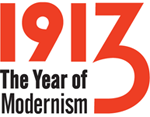L.2013.6.5: Ausstellung von Künstlergruppe Brücke im Kunstsalon Fritz Gurlit
Founded in Dresden in 1905 by a group of four architecture students—Fritz Bleyl, Erich Heckel, Ernst Ludwig Kirchner, and Karl Schmidt-Rottluff—the artist's collective Die Brücke (The Bridge) would come to be seen as one of the cornerstones of the German Expressionist movement. Modeled along the lines of a medieval artist's association, Die Brücke was devoted not only to promoting an uncompromisingly modern German school of painting but also to erasing traditional boundaries between art and life. Their name came from Nietzsche’s Thus Spoke Zarathustra (1883–85) and symbolized the bridge humankind must cross to achieve self-actualization. Initially inspired by the brightly colored canvases of Matisse, the group became equally influenced by African art, as reflected in Kirchner's design for this cover of their 1912 exhibition catalogue. Ultimately, the communal harmony of Die Brücke could not be sustained, and the group disbanded in 1913, on the eve of the First World War.









